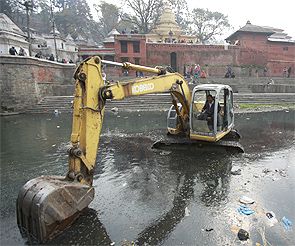 | « Back to article | Print this article |
 For more than half of all Indian households, the very personal act of defecation is an open affair, says Joel Rai
For more than half of all Indian households, the very personal act of defecation is an open affair, says Joel Rai
Isn't it curious that time and again, India's development is measured against temples? It was in 1963 that Jawaharlal Nehru, inaugurating the Bhakra Nangal dam, declared factories and dams as the temples of modern India. Many decades down, the subject of scrutiny is toilets vis-à-vis temples, after Union minister Jairam Ramesh and Gujarat Chief Minister Narendra Modi declared that the nation's focus should be toilets rather than temples.
First off, temples don't stand any competition against toilets. The 2011 Census of India notes that only 1 per cent of all households (it numbers the nation's households at 246.7 million) constitutes temples or places of worship. That puts the number of shrines at around 2,460,000. In comparison, 46.9 per cent of the households have some form of toilets, whether it be a pit latrine or a facility with water connectivity. That just proves it is easier to squat than to kneel in India.
However, Modi's angst was really about the figure on the penumbra side of the percentage - the 53.1 per cent of Indian households that don't allow a member to saunter across to a room that houses the commode. Despite a heroic decadal increase, 131 million households in India still have to make do with what the environs has to offer as defecatory amenities - natural cover offered by the wheatfield, convenient cleaning by the river bank, or easy disposal alongside filthy urban drains.
There is little consolation for Indian households without lavatories in sending their children to school when nature calls. There are 1.36 million institutes in the country for primary, middle, high school and college education. But the concern has always been that these schools, in large numbers, too lack proper sanitation facilities.
In fact, given the overall dirty picture, the government embarked on the Total Sanitation Campaign in 1999 with the objective of ensuring that all Indian households would have proper washrooms by 2020. As current figures show, the task is only half way through.
But the approach is heartening. Some states, like Sikkim (where only 12.8 per cent of households are denied the pleasure of a proper toilet), have made it mandatory for anyone fighting a panchayat election to prove that he or she had a proper toilet at home. What is more, the bill for constructing a hygienic voiding room is subsidised to the tune of Rs 10,000 by the states.
Is it any surprise then that only 2.2 per cent of Lakshadweep's households and 4.8 per cent of Kerala's lacked a loo in 2011? But the enormity of the task can be gauged from the fact that in big states like Jharkhand (78 per cent households don't have toilets), Odisha (78 per cent), Bihar (76.9 per cent) and Uttar Pradesh (64.4 per cent), the personal act of defecation is an open affair.
But Indians are not the only people who, in a majority, relieve themselves under the great blue sky. The United Nations says that 2.5 billion people in the world do not have access to a proper toilet. The situation is so grim, that the world body even has a designated day to focus attention on the problem - World Toilet Day on November 19 ever year.
Prominent people like Hollywood actor Matt Damon are campaigning for easy access to water and toilets. Damon has appeared in public with a toilet seat around his neck to startle people into realising that not everybody can amble into a personal purgatory with a book in hand whenever nature calls.
The Bill and Melinda Gates Foundation has offered millions of dollars for the creation of a toilet that is both easy to install even in impoverished countries and uses as little water as possible.
Water and sanitation go hand-in-hand and the enduring image of an early morning walk into the grasses with a lota in hand is almost a metaphor. The government has reported that 85.5 per cent of Indians now have access to a water source, whether ponds, reservoirs, borewells or tap connections. This augurs well for toilets. After all, it is only a body at peace that emerges from a toilet that can truly go and find peace of mind in a temple.